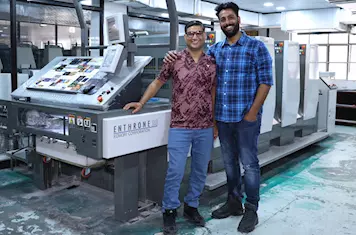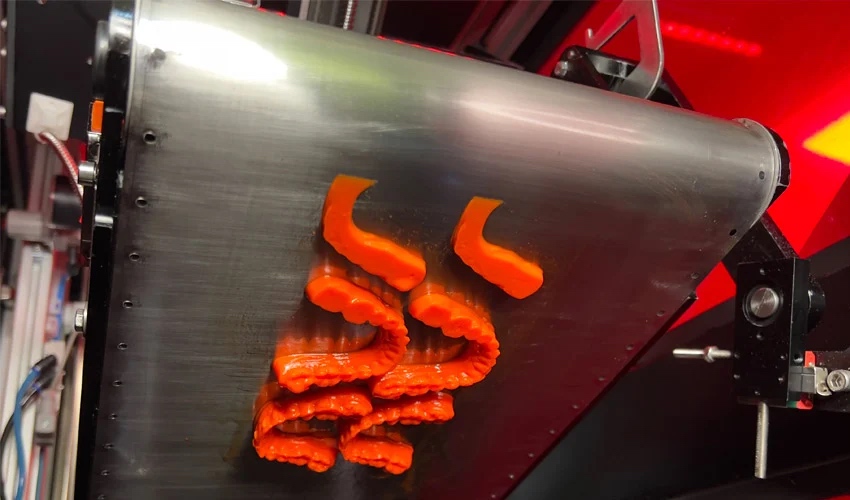
#3DStartup: Sprybuild and the Automation of Resin 3D Printing

Primarily based in Israel, Sprybuild has set itself the objective of creating automated 3D printing options, providing higher flexibility for the consumer. With this in thoughts, it has designed a resin 3D printer with a conveyor belt. As an alternative of the standard printing plate, a steel conveyor belt is used to unroll the components as they’re printed. The corporate has opted for a DLP course of, able to excessive speeds. Sprybuild can be specializing in a post-processing system, the intention being to automate your entire work circulate and provide a turnkey answer. We caught up with CEO Oleg Khalip to seek out out extra about this 3D printer, the startup’s targets and future developments.
3DN: May you introduce your self and Sprybuild?
My title is Oleg Khalip and I’m the CEO of Sprybuild. I’ve based and managed a number of manufacturing-related corporations in Ukraine since 1992. I’ve been actively concerned in invention and engineering. In 2016, I gathered a workforce of fanatics and based Sprybuild – a startup specializing within the improvement of superior 3D printing options. Since then, I’ve led and funded this challenge till the outbreak of struggle and our relocation to Haifa, Israel. It was right here that we rethought our merchandise, started to implement new concepts and solid extraordinarily necessary partnerships.
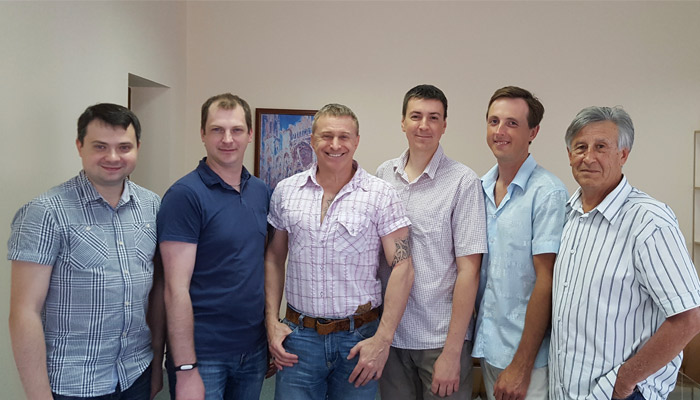
The Sprybuild workforce
Our intention is to revolutionize the manufacturing trade by providing automated, environment friendly 3D printing options that may be utilized in a wide range of sectors – from aerospace to drugs. Our improvements intention to simplify manufacturing processes, scale back prices and decrease environmental affect. We consider that 3D printing provides limitless potentialities for making a extra sustainable future, which is why we’re consistently working to enhance our applied sciences and develop their functions. At Sprybuild, we’re pleased with our workforce, who’re on the coronary heart of our modern actions. Because of their experience and inventive method, we’re capable of implement 3D printing applied sciences that not solely meet, however far exceed the effectiveness of options accessible in the marketplace.
3DN: How did the concept for Sprybuild come about?
With a background in precision engineering and chemical manufacturing, together with the assets and entrepreneurial expertise, I dreamed of radically accelerating the 3D printing course of. In 2016, with a small analysis group, we launched into the journey. In 2017, at TechCrunch Disrupt in San Francisco, we introduced our first high-speed resin 3D printer prototype in motion: on the time, we set a document for print speed-10 mm/min alongside the Z axis, nonetheless a formidable consequence. We have been impressed, and I believe that’s when Sprybuild actually turned an organization, however we nonetheless needed to perceive the challenges of the trade and set our objectives accurately.
3DN: May you inform us extra about your machine?
On the coronary heart of the Sprybuild printer is DLP expertise, with a conveyor belt instead of a printing plate. This steel belt strikes at an acute angle to the DLP projection, and contains a remarkably excessive diploma of floor stabilization, achieved by using an efficient but easy magnetic system. What’s extra, it options an automated half launch operate that nearly eliminates printer downtime.
Sprybuild’s expertise implements a strong optical interface, enabling a steady construct course of just like, however distinct from, the CLIP expertise developed by Carbon3D. The problem was twofold: to remove the necessity to inhibit the resin close to the interface and, on the similar time, to create “lifeless zones” the place the resin might stay liquid. These zones are essential to make sure a clean circulate of resin into the print zone, a key think about attaining high-speed printing. Sprybuild’s ingenuity has enabled us to develop an interface that meets these necessities, guaranteeing environment friendly resin circulate and curing solely the place needed.
We have been the primary to develop a singular steady manufacturing course of which doesn’t require resin inhibition by oxygen or mild, and which might use all kinds of UV resins. In a current prototype, we achieved secure, high-quality printing of dental fashions at a velocity of 55 mm/min (100 micron layer), with the potential of reaching 150 mm/min.
Sprybuild is creating a totally automated post-processing system for the printer. It goals to deal with the circulate of printed components sequentially, eliminating the necessity for human intervention in post-printing phases, which historically embrace cleansing, drying and curing printed objects, in addition to minimizing human contact with doubtlessly hazardous supplies resembling alcohol and resins.
This method streamlines your entire additive manufacturing course of, from printing to post-processing, making it extra environment friendly and scalable. It addresses one of many main challenges of additive manufacturing, specifically the discount of labor- and time-intensive steps after printing, which might typically grow to be bottlenecks in manufacturing flows. By automating these steps, Sprybuild not solely improves productiveness, but additionally ensures constant high quality for all printed components, as post-processing is exactly managed and executed.
Moreover, this improvement aligns with the trade’s transfer in direction of absolutely automated additive manufacturing options, the place the intention is to reduce human error and labor prices whereas maximizing yield and high quality. The mixing of an automatic post-processing system with Sprybuild’s steady resin 3D printing expertise represents a step ahead in making 3D printing extra viable for mass manufacturing and a variety of commercial functions.
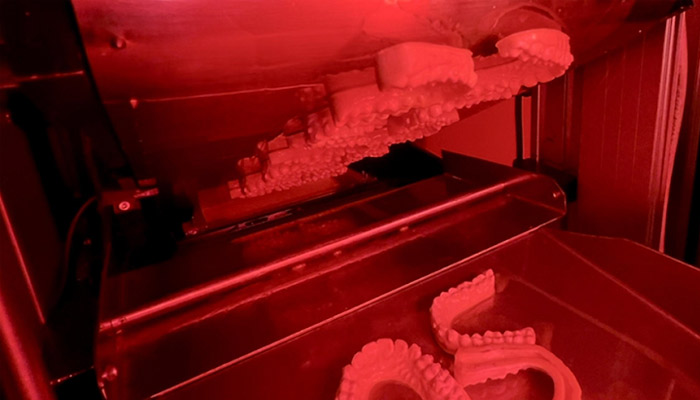
The resin 3D printer is supplied with a conveyor belt for higher productiveness and automation.
3DN: What are the functions for Sprybuild’s 3D printer?
Sprybuild provides specialised options for varied functions:
- The manufacture of dental fashions, bettering the precision of dental care.
- Within the footwear trade, our expertise will streamline the manufacturing of uppers and insoles, providing unrivalled customization and luxury.
- The flexibility of our printers extends to the manufacturing of spectacle frames, bringing new ranges of design freedom and sturdiness.
- Within the healthcare sector, our options facilitate the manufacture of listening to aids and prosthetic components, giving precedence to sufferers’ particular wants for a greater high quality of life.
- Our expertise is ideally suited to the creation of detailed combustion fashions for precision molding, important for high-quality parts in varied industries.
- The manufacturing of connectors and housings for electrical gear may also profit from important enhancements in effectivity and high quality, enabling us to satisfy the calls for of the quickly evolving electronics market.
3DN: What are Sprybuild’s subsequent tasks?
Sprybuild goals to alter the 3D printing panorama by merging autonomous {hardware} capabilities with a sophisticated AI software program stack. Though nonetheless within the early phases of software program improvement, Sprybuild has already efficiently built-in key features resembling automated slicing and nesting instantly into the printer.
The subsequent part focuses on the event of AI-based scanning and high quality validation programs. These parts will not be mere enhancements; they’re important to make sure secure, dependable printer operation. As soon as absolutely applied, they are going to allow self-calibration and an “autopilot mode” for the printing course of.
Sprybuild’s integration of superior software program and {hardware} capabilities lays the foundations for a extra sturdy and dependable subscription-based enterprise mannequin. This mannequin not solely ensures that customers all the time have entry to the most recent advances, but additionally positions Sprybuild as a companion of their operational success, offering ongoing help, updates and enhancements. This method might considerably scale back the barrier to entry for high-quality 3D printing, making it accessible to a wider vary of companies and industries.
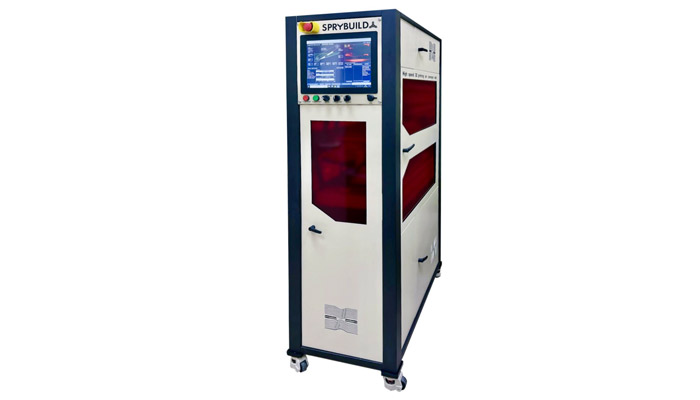
The resin machine
3DN: Any final phrases for our readers?
The unimaginable high quality and vary of merchandise we will now create with photopolymer resins is actually thrilling. Their value is falling, opening up a world of potentialities for manufacturing custom-made objects on an industrial scale. We have now every little thing from powerful, sturdy resins to versatile elastomers, particular resins that burn cleanly for molding, and even supplies that mix ceramics or metals into the combo.
SLA’s slowness is simply the tip of the iceberg. Producers face a complete host of issues: prep work will be tedious, attaining constant high quality can really feel like of venture, and I’m not speaking in regards to the lack of automation in post-processing. After which there’s the waste – these help buildings and IPA cleansing options – plus all of the guide labor and the pile of additional gear you want.
We didn’t shrink back from these challenges. We rolled up our sleeves and set ourselves formidable objectives. Seven years of blood, sweat and tears later, we’re proud to say that we’ve discovered an answer for each certainly one of them. It’s not nearly making issues sooner or cheaper. It’s about pushing the boundaries of what’s doable with 3D printing and making it a vital a part of industrial manufacturing. We’re speaking a few future the place made-to-measure would be the new norm.
What do you consider Sprybuild? Tell us in a remark under or on our LinkedIn, Fb, and Twitter pages! Don’t overlook to join our free weekly e-newsletter right here for the most recent 3D printing information straight to your inbox! You may as well discover all our movies on our YouTube channel.
*All Picture Credit: Sprybuild
